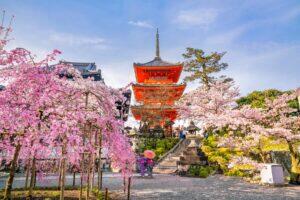Fodor's Expert Review Daigo-ji Temple
Goju-no-to, the five-story main pagoda of the Daigo-ji Temple complex, dates from AD 951 and is reputed to be the oldest existing structure in Kyoto. Daigo-ji, which includes many subtemples, was founded in AD 874 in the Eastern Mountains foothills in what is now the southeastern suburb of Yamashina Ward. Many of the smaller temples, along with the pagoda, can be found on the lower, entry level, with more up a long stone stairway that takes 45 minutes to ascend.
By the late 16th century the Daigo-ji enclave had begun to decline in importance, and its buildings showed signs of neglect. The warlord Toyotomi Hideyoshi paid a visit when the cherry trees were in bloom, and their beauty so delighted him that he ordered the complex restored. Among the notable subtemples is Sanbo-in, a 1598 reconstruction commissioned by Hideyoshi of a temple built here in 1115. The present structure has a Momoyama-period thatched roof; displayed inside are colorful, gold-leaf paintings of Chinese village... READ MORE
Goju-no-to, the five-story main pagoda of the Daigo-ji Temple complex, dates from AD 951 and is reputed to be the oldest existing structure in Kyoto. Daigo-ji, which includes many subtemples, was founded in AD 874 in the Eastern Mountains foothills in what is now the southeastern suburb of Yamashina Ward. Many of the smaller temples, along with the pagoda, can be found on the lower, entry level, with more up a long stone stairway that takes 45 minutes to ascend.
By the late 16th century the Daigo-ji enclave had begun to decline in importance, and its buildings showed signs of neglect. The warlord Toyotomi Hideyoshi paid a visit when the cherry trees were in bloom, and their beauty so delighted him that he ordered the complex restored. Among the notable subtemples is Sanbo-in, a 1598 reconstruction commissioned by Hideyoshi of a temple built here in 1115. The present structure has a Momoyama-period thatched roof; displayed inside are colorful, gold-leaf paintings of Chinese village scenes. The adjacent multistone garden combines elements of a chisen-kaiyu (stroll garden with a pond) and a karesansui (dry garden). Visitors cannot stroll the main garden, but a newer one to the left of the entrance can be entered.
Daigo-ji holds the Daigo-ichi, a monthly bazaar held on the 29th, with food and clothing stalls that line the temple walkways.
READ LESS







